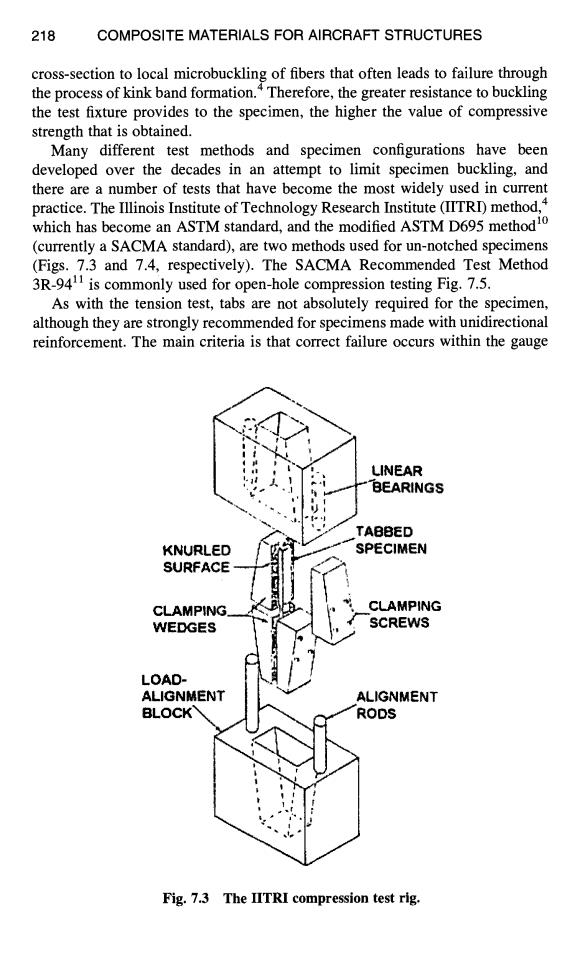正在加载图片...

218 COMPOSITE MATERIALS FOR AIRCRAFT STRUCTURES cross-section to local microbuckling of fibers that often leads to failure through the process of kink band formation."Therefore,the greater resistance to buckling the test fixture provides to the specimen,the higher the value of compressive strength that is obtained. Many different test methods and specimen configurations have been developed over the decades in an attempt to limit specimen buckling,and there are a number of tests that have become the most widely used in current practice.The Illinois Institute of Technology Research Institute (IITRD method,4 which has become an ASTM standard,and the modified ASTM D695 method10 (currently a SACMA standard),are two methods used for un-notched specimens (Figs.7.3 and 7.4,respectively).The SACMA Recommended Test Method 3R-9411 is commonly used for open-hole compression testing Fig.7.5. As with the tension test,tabs are not absolutely required for the specimen, although they are strongly recommended for specimens made with unidirectional reinforcement.The main criteria is that correct failure occurs within the gauge LINEAR BEARINGS TABBED KNURLED SPECIMEN SURFACE CLAMPING CLAMPING WEDGES SCREWS LOAD- ALIGNMENT ALIGNMENT BLOCK RODS Fig.7.3 The IITRI compression test rig.218 COMPOSITE MATERIALS FOR AIRCRAFT STRUCTURES cross-section to local microbuckling of fibers that often leads to failure through the process of kink band formation. 4 Therefore, the greater resistance to buckling the test fixture provides to the specimen, the higher the value of compressive strength that is obtained. Many different test methods and specimen configurations have been developed over the decades in an attempt to limit specimen buckling, and there are a number of tests that have become the most widely used in current practice. The Illinois Institute of Technology Research Institute (IITRI) method, 4 which has become an ASTM standard, and the modified ASTM D695 method ]° (currently a SACMA standard), are two methods used for un-notched specimens (Figs. 7.3 and 7.4, respectively). The SACMA Recommended Test Method 3R-9411 is commonly used for open-hole compression testing Fig. 7.5. As with the tension test, tabs are not absolutely required for the specimen, although they are strongly recommended for specimens made with unidirectional reinforcement. The main criteria is that correct failure occurs within the gauge I ~ ~ .~"~. KNURLED WEDGES LINEAR TAOBED • ~i CLAMPING --SCREWS Lo, o ¸ ALIGNMENT ALIGNMENT Fig. 7.3 The IITRI compression test rig